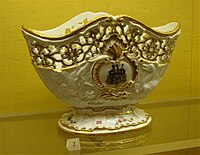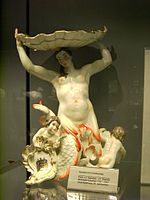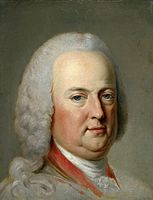Swan Service

The Swan Service (German: Schwanenservice, Polish: Serwis łabędzi) is a large service of baroque Meissen porcelain which was made for the First Minister of the Electorate of Saxony and favourite of king Augustus III of Poland, Heinrich von Brühl. Augustus had made Brühl the Supervisor of the Meissen works in 1733, then in August 1739 its director.[1] The Swan Service has been called "the most famous high baroque production in Meissen porcelain",[2] "a triumph of modelling and firing",[3] and "the most fabulous tableware conceived in porcelain".[4] After earlier work with prototypes, the Meissen designers and modellers Johann Joachim Kändler, Johann Friedrich Eberlein and (from about 1741) Johann Gottlieb Ehder created the service, which consists of over 2,200 individual pieces, between 1737 and 1741 or 1742.[5][2]
Motifs


A service on such a scale and with such lavish sculptural elements was unprecedented; a later large Meissen service, the
In January 1738 Kändler spent three days in the royal natural history collection at
Large pieces include opulent centrepieces, numerous candelabra, tureens. There are other items including teapots and cups and wall-sconces as well as the standard items of dinnerware.[9] The decoration, apart from the small painted flowers of the pattern called indianische Blumen ("Indian flowers"), is themed around water and the life within, though often mixing fresh water and marine forms. Several parts of the service depict figures from Greco-Roman mythology, like Glaucus and the dolphin-riding Galatea. Almost all pieces of the original service bear the painted impaled coat of arms of Heinrich von Brühl and his wife, countess Franziska Kolowrat-Krakowsky, though pieces were also produced for other customers. Other painted decoration on the flatware pieces is gold rims and small flowers;[10] the figures on the larger pieces are more fully painted.
History
Brühl was a loyal minister, who was allowed, as director, to commission and receive Meissen pieces free (unlike the king himself, who owned the Meissen factory). He made use of this privilege, although the Swan Service seems to have been a wedding present from the king for Brühl's marriage in November 1737.[11] Brühl's level of entertaining was exceptional even for the period, and the service à la française used at the time required large numbers of pieces of tableware, especially for Brühl, who served 80 to 100 different dishes at every "publick entertainment."[12]
Work was begun by Kändler in 1736, when some sample plates were produced. Fabrication of the moulds began in December 1737, and most shapes were completed by 1741;[2] the service was delivered piecemeal as pieces were finished. Meissen still possesses the moulds, and these were used at the time and later to produce items outside the Brühl service itself, including some in limited editions today. Mostly, these lack the armorials.[13]
Except for those pieces of the service that were on museum loan in Dresden, all other pieces of the service were lost during the last stages of World War II, when the approaching Soviet Red Army set ablaze Schloss Pförten, the family castle in today's Brody, Żary County in western Poland.[14] It is said that the surviving pieces hidden in the castle's cellars[14] were used by Soviet soldiers as targets in a version of clay pigeon shooting.[15] Today, many museums have items from it, with a trickle of pieces from the original production still appearing on the art market. London auction prices in 2015 include £31,250 for a teacup and saucer, £18,125 for a slop bowl, £6,875 for small fragments of three candlesticks, £15,000 for a saucer and £8,125 for a mustard-pot cover.[16]
-
Tureen
-
unpainted wine-cooler, J.F.Eberlein, 1740–41
-
Confectionery dish, c. 1737–41
-
Teacup and saucer, c. 1737–41
-
Display in theNational Museum, Warsaw
-
Wine-cooler by J.F.Eberlein, 1741
-
Nymph on a dish for sweets, with theBrühlcoat of arms, but a 20th-century production
-
Heinrich von Brühl by Marcello Bacciarelli, 1758–63
Notes
- ^ Ostrowski, 343; Untermyer, 118
- ^ a b c Ostrowski, 343
- ^ Coutts, 95
- ^ Grigaut
- ^ "Swan Service | porcelain tableware". Encyclopedia Britannica.
- ^ Ostrowski, 345
- ^ Quoted, Untermyer, 118
- ^ There were "old" and "new" osier patterns (Altozier and Neuozier, the latter introduced in 1742), Wrightsman, 135–136
- ^ Untermyer, 118
- ^ Ostrowski, 343–345
- ^ Young, 139–161; Ostrowski, 343
- ^ Young, 153–155
- ^ Untermyer, 118; Modern reproductions from Meissen
- ^ a b Media, Instytut Gość (July 6, 2017). "Roztrzaskany skarb". zgg.gosc.pl.
- ^ Bonham's Press release, 2012, "Chocolate cup and saucer are among rare items of important Meissen service saved from obliteration"
- Bonham's, London sales of "Fine European Ceramics": 2 December 2015, Lots 46, 44 and 45; 17 June 2015, Lots 61 and 62 respectively. Auction results search
References
- Coutts, Howard, The Art of Ceramics: European Ceramic Design, 1500–1830, 2001, Yale University Press, ISBN 9780300083873, google books
- Grigaut, Paul L., "Two Pieces from the Meissen Swan Service", Bulletin of the Detroit Institute of Arts 36 (3), 1956, Detroit Institute of Arts: 66–69. JSTOR
- Ostrowski, Jan K, DaCosta Kaufmann, Thomas, Land of the Winged Horsemen: Art in Poland, 1572–1764, 1999, Yale University Press, ISBN 9780300079180, google books
- "Untermyer" (no author given), Highlights of the Untermyer Collection of English and Continental Decorative Arts, 1977, Metropolitan Museum of Art, ISBN 9780870991691, Google books
- "Wrightsman" (no author given), The Wrightsman Collection. Vols. 3 and 4, Furniture, Snuffboxes, Silver, Bookbindings, Porcelain, 1970, Metropolitan Museum of Art, ISBN 9780870990106, Google books
- Young, Carolin C., Apples of Gold in Settings of Silver: Stories of Dinner as a Work of Art, 2002, Simon and Schuster, ISBN 9780743222020, google books
Further reading
- Pietsch, Ulrich (Ed.). Schwanenservice – Meissener Porzellan für Heinrich Graf von Brühl, Berlin: ISBN 3-361-00517-5
- Cassidy-Geiger, Maureen, "From Barlow to Büggel", Keramos, 119 (1988), pp. 54–68, for a discussion of the graphic sources
- Walcha, Otto, Meissner Porzellan. Von den Anfängen bis zur Gegenwart. Dresden: Verlag der Kunst, 1986, 8th Edition, ISBN 3-364-00012-3
- Berling, Karl, "Das Brühlsche Schwanenservice", Belvedere 10, Darmstadt 1925, pp. 80–85
External links
 Media related to Swan Service at Wikimedia Commons
Media related to Swan Service at Wikimedia Commons- Swan Service in the National Museum in Warsaw









